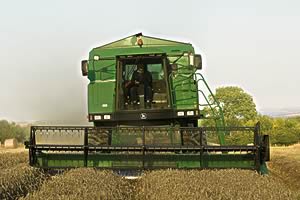 |
|||||||||
|
|||||||||||||||||||
|
|
Earlier Wheat Harvesting Priority Grows 11/09/08 An earlier start to wheat harvesting is becoming an important priority for the vast majority of growers across the country, reveals the latest national study by robust wheat breeders, RAGT Seeds.
The study, involving 300+ growers responsible for over 100,000 ha of winter wheat, reveals fully 84% keen to make an earlier start to their wheat harvest, with 60% of these considering earlier harvesting of great value. And this before the horrors of the current harvest became apparent. “With so many people having to contend with their second horrendous harvest in a row, an earlier start to harvesting will be an even greater priority for most,” points out agronomist, Cathy Hooper who co-ordinated the study. “Not least because reducing weather risk was second only to easing workload pressures in the key benefits of an earlier harvesting wheat identified by our study growers. “Unfortunately, most of today’s varieties tend to mature at a similar time to Claire or later. With the exception of Soissons which is very much a specialist choice, only Marksman and Cordiale offer particularly early harvesting. A ripening rating of -2 relative to Claire on the RL means they can be ready a full week ahead of many other wheats in practice. They are both at the quality end of Group 2, with the essential attributes of strong standing power, stable Hagbergs and a good resistance to sprouting. So they’re unlikely to present problems even if harvesting is delayed. “We harvested our early October-drilled Zebedee first on August 15 because it was in serious danger of going over,” he explains. “After getting the first piece of the Marksman in the dry the following day it took us three attempts to polish off the final 30 acres. We just kept being rained off. The fact that it was always drier than our other wheats really helped. We brought it all in at 16% moisture or less. “Now we don’t have problems of newly acquired land to contend with, we plan to make far more of the variety in the coming season by getting it drilled in our main October slot. I’m confident it will really help to reduce our harvest risk.” “We used to grow a lot of Soissons,” Phillip Corney recalls. “It suited us well but never gave much more than 3t/acre. And latterly we were having gluten problems. “With the sort of summers we’ve been having lately, I’m especially keen to keep our wheat-growing eggs in more than one basket. We’ll definitely be putting in a good acreage of Marksman again this autumn to ensure a good early start to harvesting next year. Especially so, now we know what it can do in quality terms.”
|
||||||||||||||||||

|
|
||||||||||||||||||
| home | agri-services | pedigree
pen | news | dairy | beef | machinery property | organisations | site map |
|||||||||||||||||||

